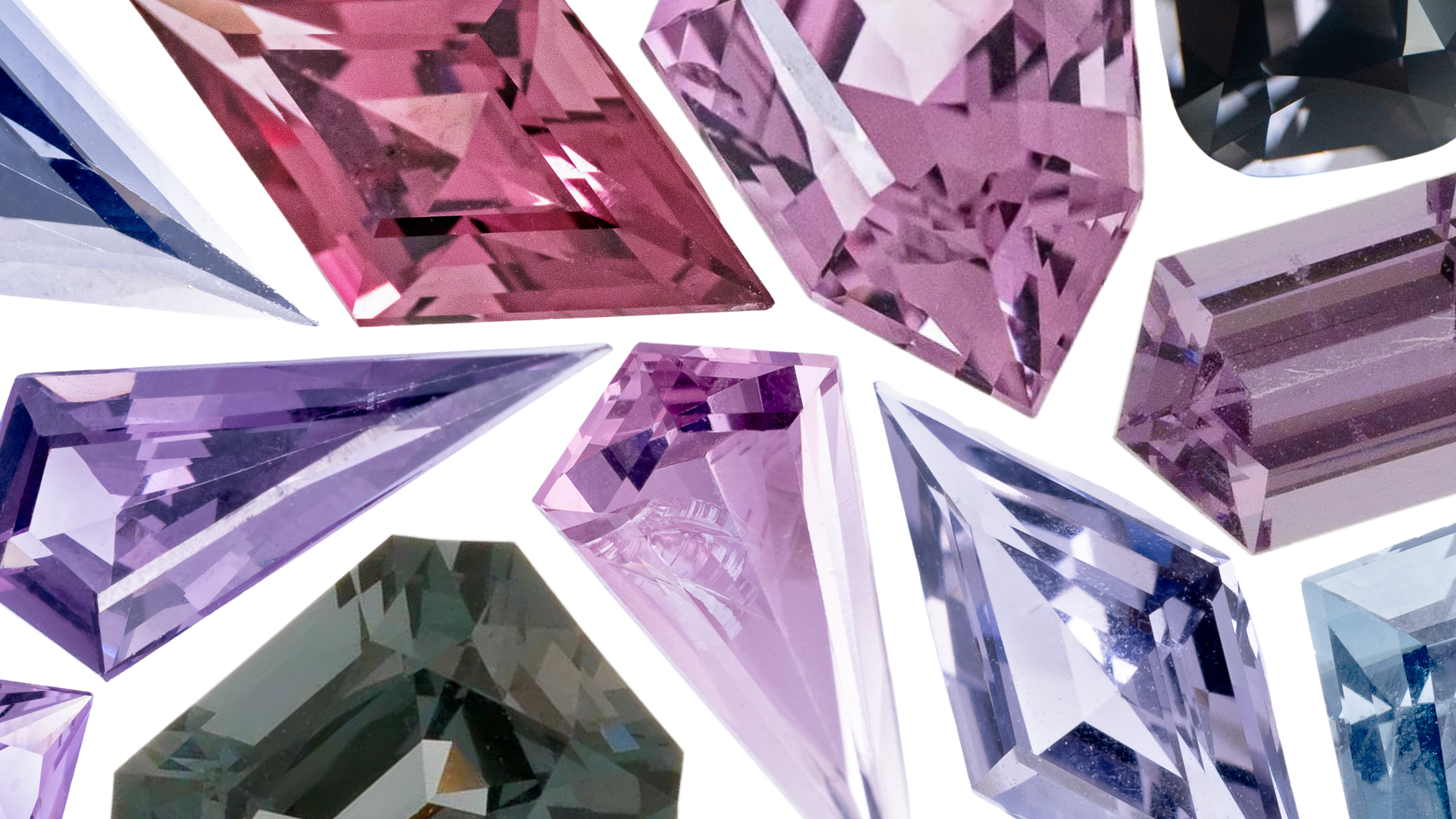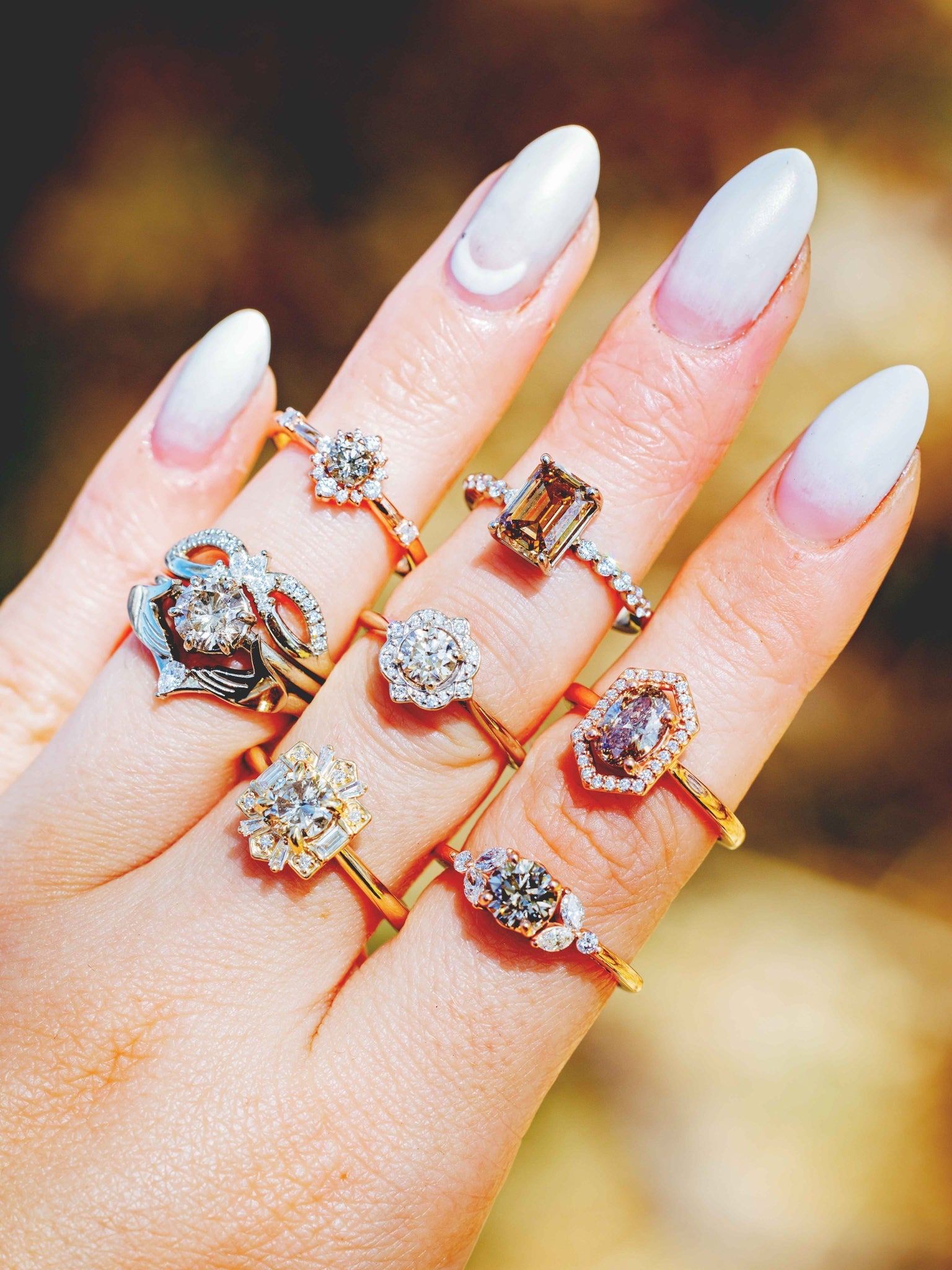
What is Spinel? One of the Jewelry Industry's Best-Kept Secrets
Undoubtedly one of the most underrated gemstones and best-kept secrets in the fine jewelry industry, spinel offers plenty of great qualities: durability, brilliance, modest price, and a variety of stunning colors. While it is a prized stone among jewelry enthusiasts and collectors, not many consumers know about spinel. The modest demand for this underrated stone means its price sits at a very affordable and reasonable range, especially considering its beauty and durability. Popularity of spinel jewelry is starting to and is expected to continue to grow quickly in the next few years as an alternative to the look and price of traditional diamond and sapphire jewelry, and we are so excited to be one of the few jewelers offering this incredible stone for custom ring designs!
Description
Spinel is a mineral composed of magnesium, aluminum, and oxygen that forms into isometric crystals, often octahedrons. While pure spinel is colorless, the introduction of trace elements during the crystal-growing process cause the stone to take on a variety of colors ranging between shades of orange, brown, red, pink, purple, blue, green, and even black. These colors come in different intensities from pale to vivid and translucent to opaque. The exact color depends on the amount and mixture of trace elements present within the stone:
- Chromium (red)
- Cobalt (blue)
- Iron (purple, blue, green)
- Vanadium (orange)

Specific colors of spinel are more rare than others. Saturated stoplight red and cobalt blue that rival the colors of ruby and sapphire are the rarest spinel colors and demand the highest prices. In fact, these spinels are even more rare than sapphires and rubies but only command a fraction of the price due to the difference in demand! Purple and lavender spinels tend to be more common, and the blues and purples in these stones frequently have a smoky or grayish tone that adds a moody and unique look that not many other gemstones offer. In fact, gray is one of the most uncommon gemstone colors and spinel is one of the only translucent gray gemstone options.

Spinel has a high refractive index, giving it great sparkle and brilliance. The luster of spinel is vitreous, or glass-like, and appears very similar to corundum (sapphire and ruby). In Burma, spinels are said to be so perfectly shiny that they are "polished by the spirits." It is typically very translucent in appearance but natural stones can also have inclusions. Rarely, spinel can have special properties like chatoyancy (cat's eye), asterism (star), and color-change. Some spinels also display fluorescence (glowing) under UV light.

History
Many famous crown jewels throughout history were mistakenly thought to be rubies and sapphires. Historically, most stones that were red or blue were automatically assumed to be ruby or sapphire. However, in 1783 mineralogist Jean Baptiste Louis Rome de Lisle developed a test to chemically differentiate rubies and sapphires from spinel - a discovery that the GIA says "gave birth to the science of gemology." While the chemical composition of corundum and spinel are very similar (both made from aluminum and oxygen), there is one key difference - spinel has magnesium while corundum does not. Imagine the shock when the United Kingdom's 170ct Black Prince's Ruby that sits front and center on the Imperial State Crown was determined to not be a ruby at all - but rather a spinel! Discoveries like this earned spinel the unfortunate nickname of "The Great Imposter." This common confusion throughout history attests to the incredible sapphire-like beauty of the spinel gemstone.
In 2016, spinel was officially declared the newest August birthstone along with peridot and sardonyx. This was one of the only additions/changes to the modern birthstone list since its creation in 1912. Spinel is a fantastic birthstone alternative to peridot for those looking for more color variation and durability than what peridot offers. In addition, it is also the gemstone used to signify the 22nd wedding anniversary.
Sourcing
Spinel is found all over the world! Common sources include Myanmar, Sri Lanka, Tanzania, Australia, even the United States. It typically forms into isometric crystals inside host rocks like marble and igneous rocks. As these rocks erode, spinel crystals become loose and are washed away where they end up in alluvial deposits. Corundum (sapphires and rubies) form in very similar conditions and often end up in the same alluvial deposits as spinel - yet another reason these stones are often confused for each other. Miners sift through the gravel and mud of these alluvial deposits, similar to gold panning, in order to find the colorful stones. This type of mining for spinel and corundum has been done for over 1,000 years!
Spinel can also be lab-grown, but not all of the color varieties seen in natural spinels can be replicated. Colorless spinel stones are almost always lab-grown, as it is very uncommon in nature for spinel to not have trace impurities that cause the stone to take on various colors. The spinels we use at Staghead Designs are natural stones unless otherwise disclosed in the product description.
Spinel Care & Cleaning
One of the greatest features of spinel is its durability! Spinel ranks eight out of ten on the Moh's hardness scale and has good toughness, making it an appropriate choice for everyday wear. Its toughness also means it can withstand being faceted into unique cuts like kite, shield, lozenge, octagon, etc., allowing for even more design possibilities!

Spinel is quite stable to heat and light, but the safest way to clean spinel jewelry is with warm water and a soft brush or cloth. Ultrasonic and steam cleaners are typically safe for spinels, but if the stone has any inclusions or fractures these can be made worse by ultrasonic and steam cleaning methods, so caution is advised.
Always remove spinel jewelry or any other jewelry before participating in any activities like:
- Manual labor (work, sports, exercising, gripping items with force such as bicycle handlebars or luggage, household chores including laundry and cleaning, etc.)
- Contact with chemicals (including chlorine, bleach, extreme temperatures, perfumes, cosmetics, hand sanitizer, lotions, etc.)
- Sleeping (jewelry rubbing on sheets can wear down prongs and increase likelihood of stones falling out)
- Any other activities which pose a risk to your ring and/or hands
To read more about our Care Guidelines, click here.
Designing a Custom Spinel Ring
With spinel's wide variety of color options, our passionate designers' skills, and three gold color (14K white, yellow, and rose) options, the design possibilities are virtually endless!
There are three ways to get a custom spinel ring from us:
1. Start with your stone: Browse the Staghead Mine to find the perfect stone first and choose/design a setting based on the stone.
2. Design your own: Work with our designers to start with scratch in designing a custom and personalized ring!
3. Browse our collections of custom handcrafted rings: Get inspiration or find your perfect ring in our collections of customizable designs. (See a ring you like and want to switch the center stone to a spinel? We can usually make that happen!)

Spinel is a fantastic gemstone for anyone looking for a unique and alternative gemstone option that provides color, durability, and a modest price. Whether you have an August birthday, are celebrating your 22nd wedding anniversary, or just want something one-of-a-kind, spinel has much to offer! Truly, this amazing gemstone is a Staghead Designs favorite, and we hope you feel the same excitement about this gemstone as we do!



